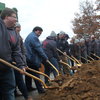Guilderland library proposes $6.9M expansion and upgrade
— Photo from Paul Mays
A play structure designed by Butler Rowland Mays for the Kingston Library — of the Sloop Clearwater and the lighthouse that are part of the town’s local landscape — is the kind of imaginative structure that draws children into the library and gives them a cozy place to play and a unique perspective on the room, said Paul Mays this week.
GUILDERLAND — Library architect Paul Mays last Thursday unveiled plans — about a year in the works — for renovating and adding to the Guilderland Public Library, making it more accessible and relevant.
The goal, Mays said, was to make the library a “third space” — a comfortable place besides work and home where people want to spend time.
Costs for the scaled-back expansion and upgrade would total about $6.9 million, roughly half of the $13 million for nearly doubling the size of the library, a plan that voters soundly defeated in 2012.
Developing the current plans, still in draft form, was a “very collaborative process” that involved months of hearing from the public as well as as working with the library’s staff, board, and foundation, Mays said.
His Ballston Spa firm, Butler Rowland Mays, has worked on projects — including master plans, new construction, renovations, and additions — with at least 30 libraries in New York State and the region.
Staff primarily wants a robust and imaginative children’s room; an improved patron-service desk; a dedicated makerspace for hands-on programming; and a “third space,” or a place the entire community can use; and indoor reading niches. Employees also wanted improved staff workspace and character added to the building.
The public, he said, is mainly interested in safety and accessibility; a café where people can feel comfortable hanging out; a robust and imaginative children’s room; and indoor reading niches. Library patrons also want to maintain and improve “the traditional collection.”
“The library is not just a transactional place where you get something and leave,” Mays said.
The collection
On Wednesday, library Director Timothy Wiles said that the print collection will stay about the same size that it is now — slightly larger than average for a municipality the size of Guilderland — but it will displayed a little differently. The current shelving system, Wiles said, consists mainly of six-unit shelves, so tall that it’s impossible to see over them. The library will move to a system of mostly four-shelf units in the main room, which will improve visibility and make it easier for parents, for instance, to track their teenager as he or she walks to the back of the library.
The library will likely have about the same budget for new acquisitions that it does now, Wiles said, but will use a little more of it to get additional copies of blockbuster titles and movies, so that people don’t have to wait so long for copies.
Shelving would be on locking wheels, and could be pushed out of the way when space is needed for a very large, high-profile event, Wiles said, such as the one featuring Mets pitcher and broadcaster Ron Darling last year. A gathering space with folding chairs could be created in the main portion of the library that would seat about 350, as compared to the 212 that is the maximum set by the fire code in the Helderberg Room.
In the future, this gathering space would probably also be used for events like the fundraising gala planned for Sept. 29, which will feature New York State Writers’ Institute Director Paul Grondahl and novelist Gregory Maguire, said Wiles. These larger events are now, of necessity, held off-site.

Children’s and young-adult spaces
The space now dedicated to the children’s room will become part of the traditional collection, allowing for more shelves, Wiles said.
A proposed addition, smaller than the one designed six years ago, would house the children’s room, drop-in play area, and program area for children’s and other events.
In June 2012, a $13 million expansion project that would have updated the library and nearly doubled its size, was defeated, 3 to 1, by about a quarter of Guilderland’s 22,245 registered voters.
Right now, the library doesn’t have a drop-in play area, Wiles said; it just has a Lego table and a train table. The new drop-in play area would likely have a large, dramatic play structure like the wooden Sloop Clearwater housed in the Kingston Library’s play area.
The children’s space at Guilderland would be larger and allow for bigger groups to gather in the program room. The program room in the current children’s area is too small to accommodate the children that regularly gather for certain story times, such as the Three Little Bird series that involves singing and movement, Wiles said; that needs to be held in the Helderberg Room.
The program room, which would be about the size of the Helderberg Room, would allow these events to stay within the children’s space.
The children’s space would have many one-and-a-half-person-sized chairs for children to sit together with parents or other caregivers, Mays said.
The young-adult space was “carved out” seven or eight years ago, said Wiles, between the children’s room and the adult collection, but it leaves something to be desired. For instance, he said, its couch, loveseat, and two chairs seat a total of just seven people.
“We’re trying to serve more than seven teens at a time,” Wiles said. The young-adult space, doubled in size, would be toward the back of the existing building, between the children’s room and the main room and would be a more comfortable place for young people to spend time.
Café and book sale
The library would like to try out a café and see how it works, Wiles said on Wednesday. It would be at the entrance, and could potentially be open earlier than the rest of the library.
The café could be run in any number of ways, Wiles said: leased to a business, done by partnering with BOCES or a local college, or run by individuals with a connection to the autism spectrum.
One audience member at the March 15 library board meeting where the plans were presented asked if the café wouldn’t encourage spills on print books, but Wiles pointed out that current library policy already allows patrons to bring food and drink into all parts of the library, except rooms that house original historical documents.
The draft plans call for a dedicated permanent book-sale space, but Wiles said on Wednesday that the permanent book sale might be moved into the café instead, to give the café a unique identity and allow the space set aside for it to be merged into the adjoining meeting room, to increase the meeting room’s size.
Currently, patrons enter and face the circulation desk, with its line of librarians standing in front of a wall. By flipping the main entrance sideways, so that patrons enter through what is now a large window to the left of the interior doors, the plan will take advantage of the building’s best architectural feature — the ability to see all the way through the building to the windows on the far wall.
Parking
The parking lot would be reconfigured. One important feature would be a narrowed traveling lane — with clearer directional signs — to slow traffic through the lot.
The book drop, now located at the entrance to the lot, which Mays said creates a bottleneck, will be moved. It will be closer to the front door, on a walking path that will extend along the center of the parking lot for easy access from either of two parking aisles. The parking lot will be larger, accommodating the two lots that the library recently gave to the school district, and will have more benches and trees. There may be a café plaza in front of the building, with outdoor tables and chairs.
Wiles said on Wednesday that parking-lot improvements may not be pursued right now, but may be set aside until five years or so from now, since staggering a project into a few different phases can increase the odds of receiving state library construction grant funding for a larger portion of each phase.
Costs
The draft plan estimates site preparation and development at $535,000. Existing building system repairs and upgrades are estimated at about $1.5 million. Building construction within the existing footprint would cost about $835,000, while new building construction would require about $1.7 million. Fire protection costs would be about $400,000.
A contingency fund would be set aside of about $600,000, and furnishings are set at about $450,000. Soft costs such as design and legal fees would total about $860,000.
The total estimated cost is $6.9 million.
Offset funding sources including the library’s capital account, the foundation and Friends of the Library, fundraising, state aid obtained through members, DLD grants, and other sources of funding are all still to be determined, as is the amount that would need to be funded through a referendum.
Mercy Care Lane
In other business, the board heard from town Supervisor Peter Barber, who spoke at the library board meeting to update the board on developments involving Mercy Care Lane. He said that town officials are looking into whether the road might be dedicated to the town in the future.
Barber said Wednesday that St. Peter’s Health Partners, which owns Our Lady of Mercy Life Center, is planning to upgrade one of its buildings, and that, in conjunction with that plan, the center approached the town with the idea of dedicating to the town the portion of Mercy Care Lane that it owns.
The rest of the private road is owned by First Columbia.
This would necessitate bringing the road to town standards, which might be done partly by St. Peter’s Health Partners and partly by the town, Barber said.
Town officials recently received a temporary easement to inspect the road, Barber said. Highway Superintendent Steve Oliver was confident, Barber said, that his department could handle work on paving the road.
The private road, which patrons leaving the library sometimes use to travel to Winding Brook Drive and out to the traffic light at Route 20, has been closed to traffic since about Christmas, Barber said Wednesday. It was his understanding that the road was closed after someone whose car was damaged by a pothole filed a claim against the road’s owner.



